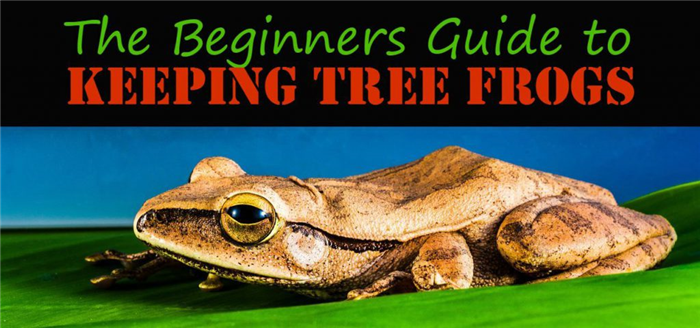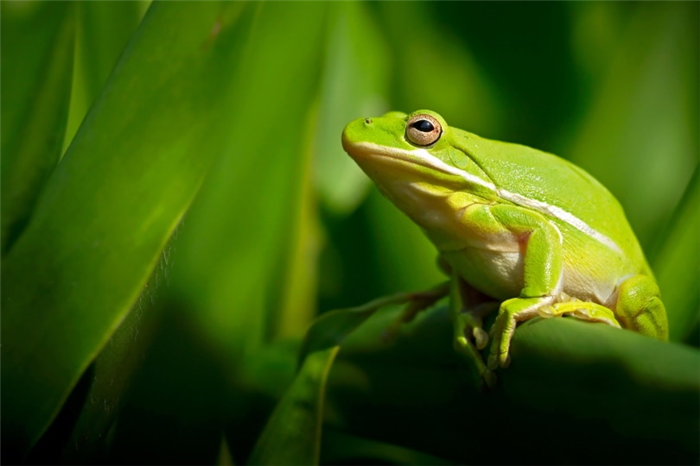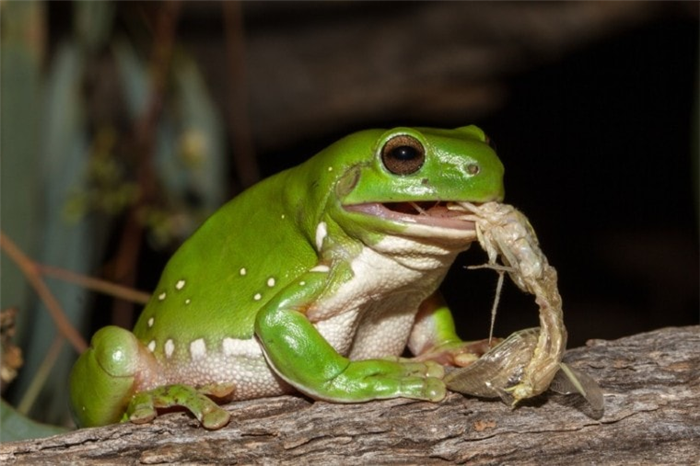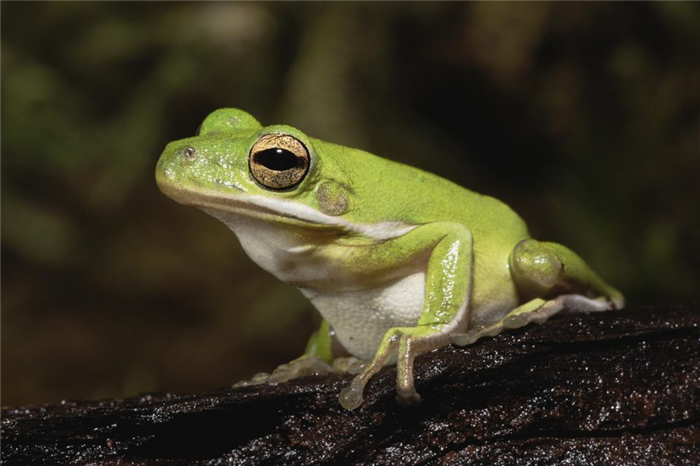What Do Tree Frogs Eat?
Tree Frogs are nocturnal creatures that come out at night to eat. Tree Frogs are generally out hunting for food or waiting for it to come to them while we sleep. But what exactly do Tree Frogs find to eat out in the wilderness?
Tree Frogs feed on pond plants and algae in the tadpole stage, and as froglets and adults, Tree Frogs generally feed on insects such as ants, crickets, moths, and small invertebrates.
If you want to know more about a Tree Frog’s diet, continue reading this article for information that will help you better understand these cute little creatures like to feed on.
Tree Frogs Eat Different Foods Depending on Stage
Tree frogs eat different things depending on the life cycle stage they are in. Here is a look at what Tree Frogs eat at each main life cycle stage:
| Lifecycle Stage | Diet | What Tree Frogs Eat |
| Egg Stage | Yolk | The yolk of their egg |
| Young Tadpole | Mostly Herbivore | Algae, decaying vegetation |
| Mature Tadpole | Omnivore | Vegetation, Aphids, Ants |
| Froglet | Insectivore, Carnivore | Bugs, small lizards, frogs |
| Adult Tree Frog | Insectivore, Carnivore | Fish, Shrimp, Lizards, Small invertebrates |
As a tadpole transforms into a froglet, it will feed on the yolk of its own egg to get the nutrients required to grow properly. Once the egg turns into a tadpole, they primarily feed on a plant-based diet. The main types of food tadpoles will eat are algae, duckweed, moss, and other soft decaying vegetation.
As more time passes and tadpoles begin their transition to froglets, they start to feed on small insects, spiders, water striders and other carnivorous materials. Once the tadpole has fully matured into a Tree Frog, its diet will change once again to larger foods including larger insects, ants, crickets, moths, and other invertebrates.
Tree Frogs are generally smaller than other frog species since they live in trees for the most part, and need to be able to carry their own body weight and stick to leaves and branches. However, some larger Tree Frogs like Australian Tree Frogs will gladly eat larger prey such as freshwater fish, shrimp, small lizards and small mammals. For the most part, adult Tree Frogs will eat anything that they can see is moving and can fit it in their mouths.
What Tree Frogs Eat During Winter
You may be wondering what Tree Frogs can eat when it’s cold outside. Thankfully, when the temperature drops and the flakes start to fly, a Tree Frog becomes dormant and goes into hibernation. Tree Frogs have incredible ways of hibernating (be sure to learn more in the article on our blog). They can even survive in freezing temperatures and will thaw out in the springtime and essentially come back to life.
But during the Winter tree frogs do not eat. They survive by entering hibernation and living off the levels of glucose in their bodies. Tree Frogs may also stock up during the Spring and Summer to be ready to hibernate in Winter.
Where Tree Frogs Eat
Since Tree Frogs have sickly little suction cup-like toes, they have the ability to get just about anywhere that they think an insect will be hanging out (CTNF).
Oftentimes you will notice these little frogs stuck to your window in the evening. This is because the light from your window attracts insects, so the Tree Frog has minimal work to do when hunting their prey. They can just sit there and wait for the insect to come toward the light and into their bellies.
You will also find Tree Frogs hanging out in the following places. Of course, this list is not all-inclusive, but it gives you an idea of the type of environment they prefer to inhabit when looking for food:
- Birdbaths
- Damp shady places
- In the foliage of trees
- In planters and garden plants
- Near ponds
- Near pool areas
- Under shrubs
- On smooth walls
What Captive Pet Tree Frogs Eat
If you have a Tree Frog as a pet, you just can’t let it loose to hunt for prey in your yard. You have to try to mirror that protein-rich diet they find in the wild since it could get sick from eating wild prey.
Captive pet Tree Frogs require a variety of insects as they would encounter in the wild. The food offered should be smaller than the distance between the frog’s eyes so they can easily digest it.
Different species of frogs have different dietary needs, but in general, Tree Frogs in captivity will eat gut-fed insects like crickets, moths, flies, and mealworms. They should be fed daily for young frogs, and every other day, or 3x per week for adult Tree Frogs. You could also dust insects with a little calcium powder to help prevent metabolic bone disease in your frogs.
More About What Tree Frogs Eat
Now that you have learned all about what Tree Frogs eat in the wild, you may find it very beneficial to attract them to your yard! And if you have a pet Tree Frog, you have a better understanding of what the diet of a domesticated Tree Frog should look like.
Learn more about Tree Frogs and what they eat in the following guides on our blog:
Common Questions About What Tree Frogs Eat
Do tree frogs eat fruit? Tree Frogs are generally insectivores and definitely carnivores and do not eat fruit. Although you could feed Tree Frog tadpoles boiled spinach, they require live insects to feed on at the froglet and adult stages of their development.
What do tree frogs eat in the rainforest? Adult Tree Frogs feed on ants, moths, crickets, mosquitoes, flies, and other insects in the rainforest. Poison Dart Frogs get their poison from the alkaloid ants the feed on. At the tadpole stage, Tree Frogs feed on decaying vegetation.
How often do tree frogs eat? Tree Frogs need food every day at the froglet stage, and every other day for Tree Frogs at the adult stage. Tree Frog tadpoles feed every day on small bits of decaying vegetation.
Disclaimer: Toadsnfrogs.com is a participant in the Amazon Services LLC Associates Program, an affiliate advertising program designed to provide a means for sites to earn advertising fees by advertising and linking to Amazon.com. Toadsnfrogs.com is compensated for referring traffic and business to these companies. This site does not constitute legal, medical, or veterinary advice. Learn more in our Terms.
The Beginners Guide to Keeping Tree Frogs as Pets

Tree frogs have an enviable reputation; even people that turn white just thinking about keeping pet tarantulas or snakes seem to fall in love with tree frogs. Something about their big round eyes, bulbous toes for climbing and rounded little bodies seems to endear them to people of all ages.
If you’re considering keeping tree frogs for the first time this guide aims to introduce you to the basics of keeping tree frogs as pets. By the end of this article you should have a realistic view of how to keep these fascinating little amphibians in captivity.
The Basics of Keeping Tree Frogs
Tree frogs typically hail from warmer parts of the world. They may be found in Southern Europe, in the Americas, Africa and in Asia. While the “classic” tree frog may be the well-known red-eyed tree frog, there are actually dozens of species of tree frog which may be encountered in the pet trade.
Most of the more common tree frog species are surprisingly easy to keep once their vivarium has been set up correctly. That said, while many tree frog species are nocturnal – and so seem to spend much of their day hiding away motionless – at night they can be surprisingly active. For this reason tree frogs require generously-proportioned cages in order to give them suitable space to climb about and jump from one plant to another.
They may live for some years in captivity, and tend to do best in “naturalistic” cages – that it to say ones that have at least a passing resemblance to their wild territory. Such cages can provide a fascinating focal point for the home.
Tree Frog Cages
Tree frogs require a moist environment if they are to be happy. For this reason glass reptile tanks tend to suit them best. If the name wasn’t enough of a clue, tree frogs also like to spend time off the ground; most commonly sitting in trees and other foliage.
For this reason it is critical that a tree frog cage is tall enough to allow the inclusion of some plant material in which they can climb, explore and hunt.
However whilst tree frogs require a moist environment, their cage shouldn’t be allowed to get too wet on a consistent basis. Doing so can allow mould to grow within the tank, and can lead to respiratory problems in amphibians.
The best cages for tree frogs are consequently those composed primarily of glass, which fascinates excellent visibility and humidity control, but which also has a mesh area. Excess moisture can then evaporate through these vents, allowing air circulation.
Tree Frog Cage Furnishings
As mentioned tree frogs tend to do best in naturalistic vivariums, so some effort should be put into making their cage seem as much like a jungle as possible. The use of compost or bark chippings as a substrate is a good start.
Second to this, one should endeavour to provide a range of objects for your tree frog to climb and hide in. Reptile-safe bark and branches can form the basis for this, supplemented with artificial plants for a real rainforest feel.
Lastly many tree frogs will appreciate a shallow dish of water on the floor of their cage. This not only provides drinking water on demand but can also help to raise the ambient humidity in the cage. It is not usual to find some species bathing in their bowl from time to time.
Tree Frog Maintenance
The two biggest factors for success when keeping tree frogs as pets are the levels of warmth and moisture present in the cage. As most tree frogs are from the tropics, they will almost always require artificial heat. This is most easily provided by a reptile heat pad, which can be attached to the outside of the vivarium, generally attached to one of the walls.
By placing the heat mat on the wall this will create a “thermal gradient” – the area closest to the mat will remain considerably warmer than the other end of the cage. As a result your tree frog will be able to move about and find an area of heat that suits him or her at the time.
In terms of humidity the easiest solution in the purchase of a houseplant spray gun. Once every day or two simply gently spray the inside of your tree frog tank. This will not only serve to raise the ambient humidity, but will also allow your tree frog to drink from the water droplets present on the plant material.
Feeding Tree Frogs
Tree frogs are carnivorous; which means they will need to eat meat in captivity. Most commonly this comes in the form of live insects, which can be bought by the tub either online or from your local reptile shop.
Common examples of insects fed to tree frogs include crickets and locusts. Before feeding all livefoods should be supplemented to ensure that they contain the right mixture of vitamins and minerals. Probably the easiest of the various supplements available is a fine powder. Simply scatter some of this onto the livefood before placing it into your tree frog tank.
Note that over time crickets and locusts will carefully groom off the powder on their body, so it is important to offer only as much food as your tree frog will eat in a short space of time. Most larger tree frogs will feed daily in this way, though can go a few days without food on occasion.
Handling Tree Frogs
Generally speaking, tree frogs are not suitable pets for people looking for an animal that they can handle. Tree frogs have very sensitive skins, which can be easily damaged by rough handling. In addition, most tree frogs won’t become “tame” and are liable to make unpredictable leaps of faith when held, through which injuries can occur.
As a result of these problems the best way to transport tree frogs – even a short distance – is to coax them into a damp Tupperware box. Placing the lid on top ensures that your tree frog cannot escape, where it can be gently transported to its new destination.
Tree Frogs


Donate
ADOPT AN ANIMAL
Tree Frogs
Status: Not Listed
Tree frogs are a diverse family of amphibians that includes over 800 species. Not all tree frogs live in trees. Rather, the feature that unites them has to do with their feet—the last bone in their toes (called the terminal phalanx) is shaped like a claw. Tree frogs also have toe pads to help them climb and many have extra skeletal structures in their toes. Tree frogs can be a variety of colors, but most of the species found in the United States are green, gray, or brown. Some of them, like the squirrel tree frog (Hyla squirella), are chameleon-like in their ability to change color.
Although tree frogs can grow to be a range of sizes, most arboreal species are very small because they rely on leaves and slender branches to hold their weight. At 4 to 5.5 inches (10 to 14 centimeters) long, the white-lipped tree frog (Litoria infrafrenata) from Australia and Oceania is the largest tree frog in the world. The largest tree frog in the United States is the non-native Cuban tree frog, which reaches 1.5 to 5 inches (3.8 to 12.7 centimeters) in length. The world’s smallest tree frogs are less than an inch (2.5 centimeters) long!
Tree frogs are found on every continent except Antarctica, but they’re most diverse in the tropics of the western hemisphere. About 30 species live in the United States, and over 600 can be found in South and Central America. Not surprisingly, lots of tree frogs are arboreal, meaning they live in trees. Special adaptations like toe pads and long legs aid them in climbing and jumping. Non-arboreal tree frogs find habitats in lakes and ponds or among moist ground cover.
Tree frogs are consumed by many different carnivorous animals. Mammals, reptiles, birds, and fish all eat tree frogs. Many of the frogs rely on camouflage to protect themselves from predators, and the more arboreal species escape ground-dwelling predators by hiding in trees.
Adult tree frogs are insectivores that eat flies, ants, crickets, beetles, moths, and other small invertebrates. However, as tadpoles, most of them are herbivores.
Almost all male frogs attract mates with advertisement calls. Each frog species has its own call so female frogs can listen for potential suitors of their own species. The frog call that most people are familiar with—“Ribbet!”—belongs to the Baja California tree frog (Pseudacris hypochondriaca). The ribbeting call has been incorporated into outdoor scenes of many Hollywood movies, even outside of the frog’s range.
Some frogs hatch as miniature adults. More commonly, however, tadpoles emerge from frog eggs. As tadpoles mature, they lose their tail and grow legs until they eventually reach their adult form. The lifespan of tree frogs varies among species. Some of them are long-lived, such as the Australian green tree frog (Litoria caerulea), which is often kept in captivity for upward of 15 years. Species with lifespans of less than three years are considered short-lived. North America’s gray tree frogs (Hyla versicolor and Hyla chrysoscelis) are somewhere in the middle with a lifespan of five to nine years.
Amphibians are declining worldwide and are collectively one of the most at-risk groups for extinction. They breathe through their skin, which makes them especially sensitive to environmental change. Threats to tree frogs include habitat destruction, pollution, climate change, and diseases like chytridiomycosis.
Not all members of the tree frog family Hylidae live in trees, and not all frogs that live in trees are in the hylid family.
American Green Tree Frogs: Species Profile
Lianne McLeod, DVM, is a small animal and exotic pet expert with over a decade of experience writing about veterinary care. After caring for animals in her veterinarian practice, Lianne went on to study biology and research water quality and chronic disease at the University of Saskatchewan.

Emily Estep is a biologist and fact checker focused on environmental sciences. She received a Bachelor of Arts in Journalism and a Master of Science in Plant Biology from Ohio University. Emily has been a proofreader and editor at a variety of online media outlets over the past decade and has reviewed more than 200 articles for The Spruce Pets for factual accuracy.

Adam Jones / Photodisc / Getty Images
American green tree frogs are native to the southeast U.S. from Florida to Virginia, and as their name indicates, they are a bright green color, which helps them camouflage in the wild with the surrounding foliage. They have a light white or cream-colored stripe from the side of the head down to the flanks.
American green tree frogs are small. Their skin is porous and not recommended for much handling, but they are one of the easier frogs to care for even for a novice. Maintaining the right environment for these hardy amphibians is not too difficult, but you will need to devote at least an hour each week to clean out the habitat.
Species Overview
Common Name: American green tree frog
Scientific Name: Hyla cinerea
Adult Size: Up to 2 1/2 inches long
Life Expectancy: 2 to 5 years
American Green Tree Frog Behavior and Temperament
These small frogs are timid and do not tolerate handling; they are squirmy and will resist it. Some frogs, after many years in captivity, may grow to accept it. But like most frogs, their skin is delicate and continuous hand contact can damage their skin.
Do not plan on keeping this frog’s habitat in your bedroom. As nocturnal creatures, the males are especially active and vocal at night. American green tree frogs are not cuddly pets, but they are fun to watch. Their big eyes seem to look longingly at a spot, and their mouths always appear to be perpetually smiling.
Click Play to Learn More About the Cute and Shy American Green Tree Frog
Housing the American Green Tree Frog
A minimum 10-gallon tank is suitable as a terrarium for green tree frogs, although larger works well too. Frogs are arboreal, spending most of their time in trees. The height of the cage is more important than the floor space, so a tall tank is best. Get a secure mesh or wire cover to prevent escape.
Climbing is essential for this species. Provide a variety of branches, live plants, or artificial vegetation. Ensure any wood collected from the outdoors is pesticide-free. You will need to treat or sanitize harvested wood to remove harmful bacteria or bugs. Driftwood and cork bark also make suitable cage furnishings.
Unlike many other frog species, the American green tree frog doesn’t require any special heating considerations, unless it drops lower than 70 degrees Fahrenheit in your home. It’s entirely nocturnal, and no supplemental ultraviolet light is needed. It will, however, need a humid environment.
Thoroughly clean the enclosure once a week. Do not use soap as detergents can kill your frog. Make sure your hands are clean (but not recently soap-cleaned) or use latex-free gloves. Gently place the frogs in a small container.
Take everything out, rinsing and scrubbing under hot water. The tank itself will need to be cleaned too (with hot water, no soap). As for the bedding, use washable liners, such as reptile carpeting or washable coconut fiber mats. You can use a gentle laundry detergent for the liner, but it must be rinsed thoroughly with cold clean water. To cut your cleaning time, have two pieces of tank liners, so when one is dirty, you will always have a clean one ready for use.
The temperature needs of this frog are similar to humans; they thrive at temperatures from 70 to 75 degrees Fahrenheit. As these creatures are cold-blooded, they need to regulate their internal body temperature. They do this by moving around in their cage to cool down or get warm. Provide a thermal gradient or range of temperatures in the cage. You can do this by putting a ceramic heat emitter in one corner or end of the cage. The temperature should not exceed 82 degrees Fahrenheit in that warm spot.
Light
This animal is nocturnal and will likely sleep during the day. It does not require lights, but a UVB fluorescent light tube (5.0) can be beneficial but not necessary for this species. The invisible ultraviolet rays may help your frog metabolize calcium.
Humidity should be around 50 to 60 percent during daytime and spike to 80 to 100 percent at nighttime. Never let the humidity level fall below 50 percent at any time. A hygrometer or humidity gauge will help you check moisture levels. Automated misters and foggers can provide moisture on a timer if you are not home to mist your cage regularly with a spray bottle.
Substrate
Substrate is the bedding or lining for the bottom of your pet’s cage. The safest, easiest, and most economically efficient choices are reptile carpet or a coconut fiber mat. These are easily washable and safer since your frog cannot mistakenly ingest it.
However, you can still use other substrates, such as cypress mulch or organic soil, moss, cork bark, or smooth gravel. You can try to clean small gravel every week, but it would require boiling to sanitize it adequately, so it’s best to replace it entirely every week. If your frog seems to be eating some of its substrate with its insect meal, consider switching to a reptile carpet or a coconut fiber mat which can prevent health issues down the road.
Terrarium Plants
When selecting plants for your frog’s cage, get plants that thrive in a similar climate: temperatures in the 70s, high humidity, and lower light. Also, make sure your plant selections are not toxic to amphibians. Your best options will be sturdy ferns or Philodendron.
What Is a Tree Frog’s Diet?
A tree frog’s diet includes the food and nutrients it needs to thrive. As insectivores, tree frogs can eat insects like crickets, fruit flies, houseflies, ants, moths, and worms to maintain a healthy diet.
American green tree frogs are generally good eaters and exclusively eat insects. Crickets can make up the bulk of a green tree frog’s diet. The crickets should be gut-loaded—fed a high-protein, nutritious meal before being offered to the frog—and dusted with a calcium and multivitamin supplement a couple of times a week.
Tree frogs will likely eat more in the spring and summer months than in the winter. Feed smaller frogs daily, while larger frogs can be fed daily or every other day. Expect to feed three or four insects per feeding. Do not overdo it. Frogs are opportunistic feeders and can grow obese. If it appears that your frog is getting obese, cut back on the number of feedings per week. If your frog appears overweight, it could also benefit from more space to move around and get exercise.
Provide a large, shallow, sturdy water dish with dechlorinated water. It must be shallow since these frogs are not good swimmers. Mist the cage daily with dechlorinated water to maintain humidity. Frogs absorb water from the habitat’s ambient moisture through their skin. They also may drink water droplets on plants or tank walls.
Common Health Problems
As with most amphibians, bacterial and fungal infections of the skin and eyes are common ailments. Pus (which may look cheesy), swelling, or redness are signs of disease. Although less common in frogs than in other reptiles and amphibians, respiratory infections can occur in frogs that have enclosures with inadequate or too much humidity. Symptoms of a respiratory infection include wheezing, drooling, and general lethargy.
If your frog is not eating well and shows no other apparent symptoms, it may have a parasitic infection. Usually, this needs to be diagnosed by an exotics veterinarian who specializes in reptiles and amphibians.
The vet should take a yearly fecal sample to check that your frog doesn’t have an overgrowth of usual parasites. Also, pet frogs are susceptible to ammonia poisoning, which is a potentially fatal condition that occurs when wastes accumulate in an animal’s enclosure. Ammonia build-up can be prevented by regular, weekly cleaning.
All of these ailments can be treated by a qualified vet if caught early.
Choosing Your American Green Tree Frog
Frogs can make lovely pets, but frogs in the wild are facing population declines and extinction due to human encroachment. If you take in a wild-caught frog as a pet, it may have diseases or health issues.
Buy a locally captive-bred frog from a reputable breeder and make sure it is tested free of disease. You can usually find a breeder through an exotics veterinarian, another frog owner, or a reptile expo. Reptile shows typically have amphibians on display and for sale, too. Most American green tree frogs cost about $10.
Look for an active, alert animal that has clear eyes with skin that looks free of bumps or cuts. If you can watch it eat before deciding, that’s ideal; most frogs will not refuse food unless they’re unwell. Likewise, if the frog you are considering seems lethargic or is having trouble breathing, or if its abdomen seems bloated, these may be signs of illness.
Similar Species to American Green Tree Frogs
If an American green tree frog interests you, you may want to look into related species:
Otherwise, check out all of our other frog profiles.
In the wild, American green tree frogs live in the southeast United States.
Female tree frogs lay their eggs in shallow water; the eggs will attach to the roots of nearby plants.
American green tree frogs cost about $10 each.
The Spruce Pets uses only high-quality sources, including peer-reviewed studies, to support the facts within our articles. Read our editorial process to learn more about how we fact-check and keep our content accurate, reliable, and trustworthy.
Llewelyn, Victoria K. et al. Permeability Of Frog Skin To Chemicals: Effect Of Penetration Enhancers. Heliyon, vol 5, no. 8, 2019, p. e02127. Elsevier BV, doi:10.1016/j.heliyon.2019.e02127
Densmore, Christine L, and David Earl Green. Diseases of amphibians. ILAR journal vol. 48,3 (2007): 235-54. doi:10.1093/ilar.48.3.235
McNamara, Sean et al. Husbandry, General Care, And Transportation Of Xenopus Laevis And Xenopus Tropicalis. Methods In Molecular Biology, 2018, pp. 1-17. Springer New York, doi:10.1007/978-1-4939-8784-9_1
Final Thoughts
Tree frogs are beautiful and exceedingly interesting creatures to watch, and most species can make great pets. With the correct care and diet, they can easily live for up to 8 years and are generally easy to house and care for. Most tree frog species will be happy on a diet of insects, specifically gut-loaded crickets. That said, depending on the species that you decide to adopt, you’ll need to thoroughly research the proper diet that they need to help them thrive.
Featured Image Credit: Ken Griffiths, Shutterstock
Lead Pet Expert & Pet-ditor in Chief
Nicole is the proud mom of 3 rescue fur babies, Baby, a Burmese cat; Rosa, a New Zealand Huntaway; and Mac, a Lab/Mastiff. A Canadian expat, Nicole now lives on a lush forest property with her Kiwi husband and new baby daughter in New Zealand. She has a strong love for all animals of all shapes and sizes (and particularly loves a good interspecies friendship) and wants to share her animal knowledge and other experts’ know ledge with pet lovers across the globe. . Read more
